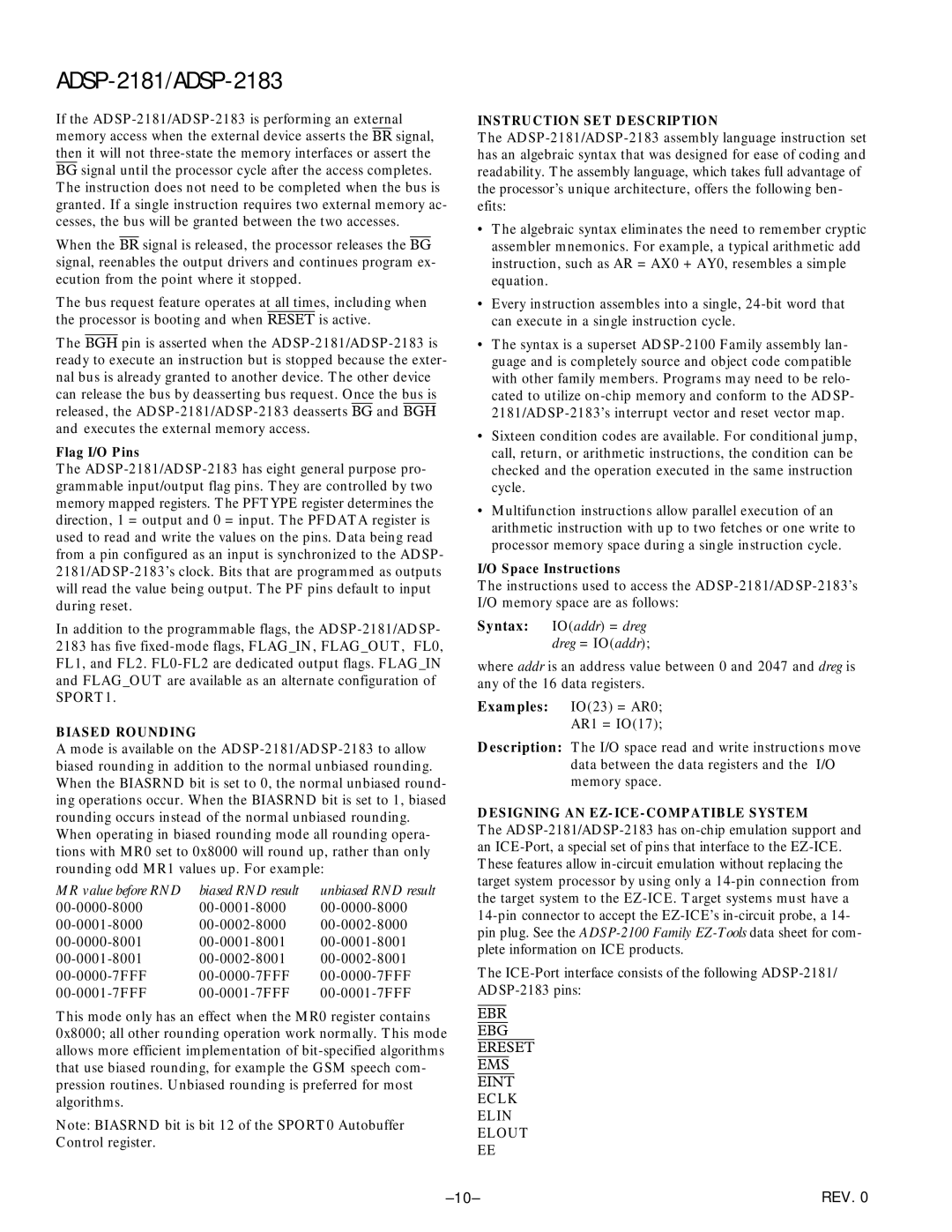ADSP-2181/ADSP-2183
If the ADSP-2181/ADSP-2183 is performing an external
memory access when the external device asserts the BR signal, then it will not three-state the memory interfaces or assert the BG signal until the processor cycle after the access completes. The instruction does not need to be completed when the bus is granted. If a single instruction requires two external memory ac- cesses, the bus will be granted between the two accesses.
When the BR signal is released, the processor releases the BG signal, reenables the output drivers and continues program ex- ecution from the point where it stopped.
The bus request feature operates at all times, including when the processor is booting and when RESET is active.
The BGH pin is asserted when the ADSP-2181/ADSP-2183 is ready to execute an instruction but is stopped because the exter- nal bus is already granted to another device. The other device can release the bus by deasserting bus request. Once the bus is released, the ADSP-2181/ADSP-2183 deasserts BG and BGH and executes the external memory access.
Flag I/O Pins
The ADSP-2181/ADSP-2183 has eight general purpose pro- grammable input/output flag pins. They are controlled by two memory mapped registers. The PFTYPE register determines the direction, 1 = output and 0 = input. The PFDATA register is used to read and write the values on the pins. Data being read from a pin configured as an input is synchronized to the ADSP- 2181/ADSP-2183’s clock. Bits that are programmed as outputs will read the value being output. The PF pins default to input during reset.
In addition to the programmable flags, the ADSP-2181/ADSP- 2183 has five fixed-mode flags, FLAG_IN, FLAG_OUT, FL0, FL1, and FL2. FL0-FL2 are dedicated output flags. FLAG_IN and FLAG_OUT are available as an alternate configuration of SPORT1.
BIASED ROUNDING
Amode is available on the ADSP-2181/ADSP-2183 to allow biased rounding in addition to the normal unbiased rounding. When the BIASRND bit is set to 0, the normal unbiased round- ing operations occur. When the BIASRND bit is set to 1, biased rounding occurs instead of the normal unbiased rounding. When operating in biased rounding mode all rounding opera- tions with MR0 set to 0x8000 will round up, rather than only rounding odd MR1 values up. For example:
MR value before RND | biased RND result | unbiased RND result |
00-0000-8000 | 00-0001-8000 | 00-0000-8000 |
00-0001-8000 | 00-0002-8000 | 00-0002-8000 |
00-0000-8001 | 00-0001-8001 | 00-0001-8001 |
00-0001-8001 | 00-0002-8001 | 00-0002-8001 |
00-0000-7FFF | 00-0000-7FFF | 00-0000-7FFF |
00-0001-7FFF | 00-0001-7FFF | 00-0001-7FFF |
This mode only has an effect when the MR0 register contains 0x8000; all other rounding operation work normally. This mode allows more efficient implementation of bit-specified algorithms that use biased rounding, for example the GSM speech com- pression routines. Unbiased rounding is preferred for most algorithms.
Note: BIASRND bit is bit 12 of the SPORT0 Autobuffer Control register.
INSTRUCTION SET DESCRIPTION
The ADSP-2181/ADSP-2183 assembly language instruction set has an algebraic syntax that was designed for ease of coding and readability. The assembly language, which takes full advantage of the processor’s unique architecture, offers the following ben- efits:
•The algebraic syntax eliminates the need to remember cryptic assembler mnemonics. For example, a typical arithmetic add instruction, such as AR = AX0 + AY0, resembles a simple equation.
•Every instruction assembles into a single, 24-bit word that can execute in a single instruction cycle.
•The syntax is a superset ADSP-2100 Family assembly lan- guage and is completely source and object code compatible with other family members. Programs may need to be relo- cated to utilize on-chip memory and conform to the ADSP- 2181/ADSP-2183’s interrupt vector and reset vector map.
•Sixteen condition codes are available. For conditional jump, call, return, or arithmetic instructions, the condition can be checked and the operation executed in the same instruction cycle.
•Multifunction instructions allow parallel execution of an arithmetic instruction with up to two fetches or one write to processor memory space during a single instruction cycle.
I/O Space Instructions
The instructions used to access the ADSP-2181/ADSP-2183’s I/O memory space are as follows:
Syntax: IO(addr) = dreg dreg = IO(addr);
where addr is an address value between 0 and 2047 and dreg is any of the 16 data registers.
Examples: IO(23) = AR0;
AR1 = IO(17);
Description: The I/O space read and write instructions move data between the data registers and the I/O memory space.
DESIGNING AN EZ-ICE-COMPATIBLE SYSTEM
The ADSP-2181/ADSP-2183 has on-chip emulation support and an ICE-Port, a special set of pins that interface to the EZ-ICE. These features allow in-circuit emulation without replacing the target system processor by using only a 14-pin connection from the target system to the EZ-ICE. Target systems must have a 14-pin connector to accept the EZ-ICE’s in-circuit probe, a 14- pin plug. See the ADSP-2100 Family EZ-Toolsdata sheet for com- plete information on ICE products.
The ICE-Port interface consists of the following ADSP-2181/ ADSP-2183 pins:
EBR
EBG
ERESET
EMS
EINT
ECLK
ELIN
ELOUT
EE

